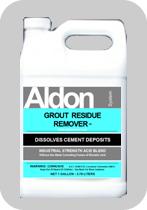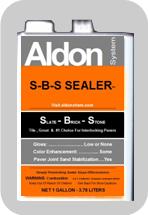|
Cleaning Rust Stains - you need to know the source.
Brown rust type stains can be caused by:
- Water contact with metal and then running to concrete, tile, grout, etc. This can be water contact with reinforcing bars in concrete slabs (look for water rundown markings), metal railings, fixtures, etc.
- Water bringing minerals out of natural stone. See below regarding prevention of this condition.
- Acid (usually muriatic acid) used in cleaning tile and masonry. Acid reaches metal and oxidizes (rusts) it. Water than moves the rust particles and leaves streaks. Neutralize the acid by saturating with water and baking soda - let dry thoroughly. Test with litmus paper (drug store item?) for acid content before and after as best you can.
Last thing is to seal it well per the Aldon Sealer Selector with one of the penetrating type sealers. This will help to prevent future moisture reaction with any remaining acid in the surface.
Rust stains running down the face of step "risers" can be because water runs down the face, then toward the back, then down the next face. A drip channel cut into the underside can prevent this and can be done by the contractor. Or, the water source is back from there and getting into the slab and migrating to those points. The rust can be from reinforcing bar in the concrete and especially if the "rebar" matt was placed on the ground and the concrete poured on top. Rebar matts should be 1/3 of the slab thickness from the earth.
What may help is a clear, flexible silicone caulk at any points of water entry to the slab - and possibly at the underside junction of the slab and riser.
Light rust stains can be cleaned with "Grout Restoration".

The strength of the Grout Restoration can be increased (diluted less) to accomplish a light etching of a cement ( concrete slab, paver, grout) surface. This should remove the top 1/32" to reveal unstained grout below.
For heavy, worst case type rust stain situations (or large areas to treat) - test the use of

Start diluted per the label and increase strength as necessary. For very deep and bad staining, "Grout Residue Remover" will continue to remove the surface layers of concrete, marble, and limestone until unstained area is reached.
After getting the surface to look as good as possible, seal with one of the sealers that is indicated to have color enhancing properties. This will darken the surface to some degree which tends to disguise color variations.
And also, of course, will protect the surface against damage of future rust stains.
If you have a stone that "bleeds" out rust:
After cleaning as above, seal with S-B-S Sealer per directions.
 This sealer will penetrate into the stone, and the stone crevices, to lock the iron oxide pigment in place and prevent "bleed out".
This sealer will penetrate into the stone, and the stone crevices, to lock the iron oxide pigment in place and prevent "bleed out".
Note:
Sometimes cleaning is a trial and error process. The cause of the problem might be different than thought, or have multiple causes and results that must be handled in steps. In rare cases, it cannot be cleaned. Proceed as though it is an experiment whose results must be evaluated.
Any Aldon cleaner has more than one purpose. It is not limited to only this cleaning project.
|